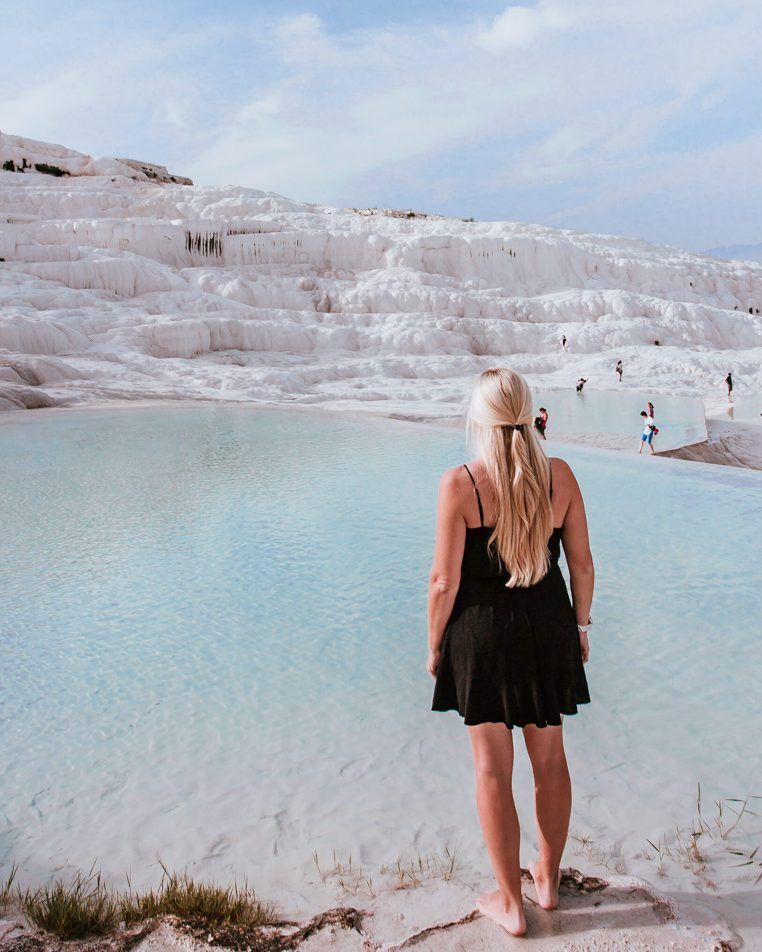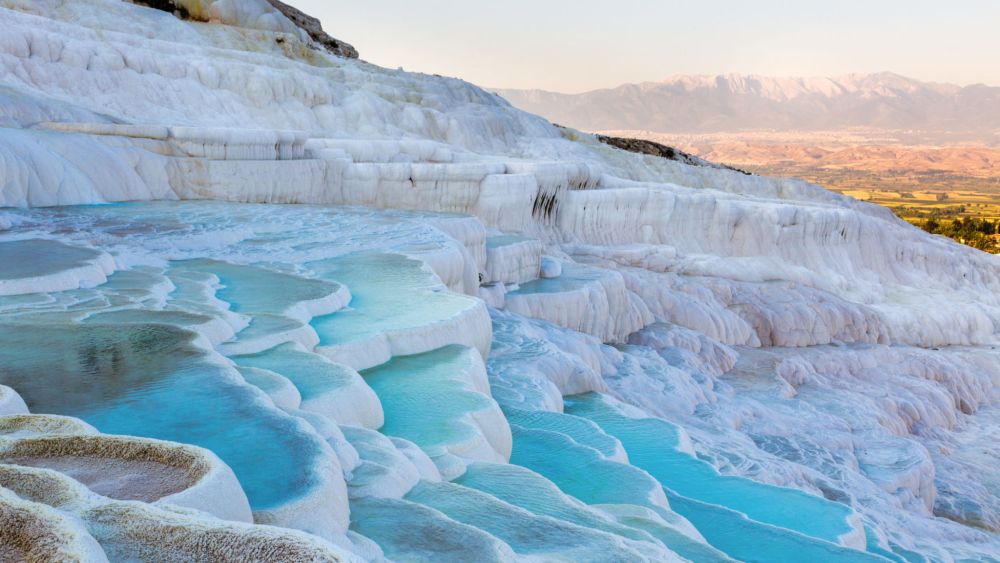
Imagine a landscape so surreal it seems plucked from a dream: gleaming white terraces, cascading like a frozen waterfall down a hillside, filled with pools of turquoise thermal water. This is not a fantasy, but the breathtaking reality of Pamukkale, Turkey’s "Cotton Castle." A UNESCO World Heritage site, Pamukkale is a spectacular fusion of natural wonder and ancient history, where mineral-rich hot springs have sculpted the earth for millennia, attracting visitors since the dawn of the Roman Empire.
But visiting this geological marvel is more than just snapping a photo. To truly experience its magic, you need to understand its past, explore its hidden corners, and navigate its unique rules. This comprehensive guide will provide you with all the essential tips to make your journey to Pamukkale an unforgettable one, covering everything from its rich history and must-see attractions to the best time to visit, where to stay, what to eat, and how to get there.
A Glimpse into History: From Holy City to Natural Spa
Related Articles about The Cotton Castle of Turkey: A Complete Guide to Pamukkale’s Thermal Pools:
- Conquering the Dragon: Your Essential Guide to Traveling the Great Wall of China
- Exploring the Jewel of the Himalayas: A Guide to the Top Hotels and Experiences in Kathmandu
- Munich Unveiled: A Comprehensive Travel Guide to Bavaria’s Heart
- Seychelles: Where Paradise Unfolds – A Journey Through History, Beauty, and Unforgettable Experiences
- Nepal: A Journey Through Mountains, Monasteries, and Ancient Kingdoms
The story of Pamukkale is twofold: one of geology and one of humanity. The geological tale began thousands of years ago. Deep beneath the earth, volcanic activity heats water, infusing it with a high concentration of calcium carbonate. As this water reaches the surface, the pressure change causes it to release carbon dioxide, depositing the calcium carbonate as a soft, gel-like substance that hardens over time into travertine. Layer upon layer, this process has created the magnificent white terraces, or travertines, that define the landscape today.
Recognizing the healing properties of these thermal waters, the Attalid kings of Pergamon established the spa city of Hierapolis on the plateau above the travertines in the 2nd century BC. Under Roman rule, Hierapolis flourished, becoming a bustling metropolis and one of the most prominent health centers of the ancient world. People flocked from all corners of the empire to bathe in its waters, which were believed to cure a variety of ailments. The city was adorned with grand temples, a colossal theatre, and a sprawling necropolis, a testament to its wealth and importance.
After the Roman and Byzantine eras, a series of devastating earthquakes eventually led to the city’s abandonment. The travertines, however, continued their silent, beautiful work. In the 20th century, the rise of tourism brought new challenges, with hotels built directly on the terraces, causing significant damage. Fortunately, in 1988, the site was declared a UNESCO World Heritage site, leading to the demolition of the hotels and the implementation of strict conservation measures that protect its fragile beauty for future generations.
The Main Attractions: More Than Just White Terraces
A single ticket grants you access to a vast complex that includes both the natural wonder of the travertines and the historical ruins of Hierapolis. To do it justice, plan to spend at least half a day, if not a full one.
1. The Travertine Terraces (Pamukkale)
This is the main event. The experience begins as you remove your shoes and socks—a mandatory rule to prevent erosion and staining of the delicate calcite deposits. Walking on the terraces is a unique sensory experience. The surface can be bumpy and textured, with a thin film of warm, mineral-rich water flowing gently over your feet. The main pathway guides you up the hillside through a series of man-made pools where you can sit and soak. The water is pleasantly warm, not hot, making it perfect for a relaxing dip. The stark white of the ground against the brilliant blue of the sky and water is visually stunning, especially during sunrise or sunset.
2. Hierapolis Ancient City
Once you reach the top of the travertines, the sprawling ruins of Hierapolis await. Don’t make the mistake of skipping them.
- The Grand Theatre: One of the best-preserved Roman theatres in Turkey, this magnificent structure could once seat over 15,000 spectators. Climb to the top tier for a breathtaking panoramic view of the entire Hierapolis plain. The intricate details on the stage front (scaenae frons) are remarkably intact.
- The Necropolis: Stretching for over two kilometers, the Necropolis of Hierapolis is one of the largest and most diverse ancient cemeteries in Anatolia. You’ll find a fascinating array of tombs, from simple sarcophagi to grand temple-like mausoleums and circular tumuli, reflecting the various cultures that passed through the city.
- The Hierapolis Archaeology Museum: Housed within a beautifully restored 3rd-century Roman bath complex, this museum showcases exquisite artifacts unearthed from Hierapolis and nearby sites like Laodicea. Highlights include ornate sarcophagi, delicate glassware, and striking statues of gods and emperors.
- The Temple of Apollo and the Plutonium: The city’s main temple was built over a geological fault line, next to what was known as the Plutonium, or Pluto’s Gate. This cave emitted toxic volcanic gases and was considered an entrance to the underworld in ancient times, used by priests for religious rituals.
3. Cleopatra’s Antique Pool (The Sacred Pool)
For a truly unique experience, pay the separate entrance fee to swim in Cleopatra’s Antique Pool. This geothermally heated pool is filled with the same mineral water as the travertines, but here you swim amidst a jumble of fallen Roman columns and marble fragments from a nearby temple that toppled during an earthquake. The water is a constant, balmy 36°C (97°F), and its effervescent quality feels like bathing in champagne. It’s a magical, historical spa experience unlike any other.
Essential Travel Tips for a Perfect Visit
- Go Barefoot, But Be Prepared: You must be barefoot on the travertines. Bring a small bag or backpack to carry your shoes. The surface can be slippery in some areas, so walk carefully.
- Pack Smart: The sun reflecting off the white surface is incredibly intense. Sunglasses are non-negotiable. Also pack high-SPF sunscreen, a wide-brimmed hat, swimwear, and a lightweight towel. Water shoes can be useful for walking around the Hierapolis ruins, which are extensive and have uneven terrain.
- Arrive Early or Stay Late: Pamukkale is one of Turkey’s most popular attractions. To avoid the peak crowds and the harsh midday sun, aim to arrive right when it opens (around 6:30 AM in summer) or stay until sunset. The "golden hour" light casts a spectacular glow on the terraces, making for incredible photos and a more serene experience.
- Stay Hydrated: Especially from June to August, the heat can be draining. Carry a large bottle of water with you. There are cafes and vendors at the top of the terraces, but they are more expensive.
- Respect the Rules: Stick to the designated pathways and pools. Walking on the dry, off-limits travertine formations is strictly forbidden as it damages their structure and color. You will see guards enforcing this rule.
- Choose Your Entrance: There are three entrances: the Pamukkale town entrance at the bottom of the hill, the north entrance near the necropolis, and the south entrance. For the classic experience, start at the town entrance and walk up the travertines. If you have mobility issues or want to see Hierapolis first, take a taxi to the north entrance and walk downhill.
When to Go: The Best Time to Visit
The best time to visit Pamukkale is during the shoulder seasons: spring (April-May) and autumn (September-October). During these months, the weather is pleasantly warm without being oppressively hot, and the crowds are more manageable than in the summer. The landscape in spring is particularly lovely, with wildflowers blooming around the ancient ruins.
Summer (June-August) is the peak tourist season. While you’re guaranteed sunny days, temperatures can soar above 40°C (104°F), making it uncomfortable to explore the vast, unshaded site of Hierapolis.
Winter (November-March) offers a completely different experience. You might have the place almost to yourself, and on a cool day, the warm thermal water is especially inviting. However, the weather can be cold and rainy, and the skies are often overcast, which diminishes the brilliant contrast of the white and blue.
Where to Stay: Accommodation Options
- Luxury & Spa Hotels: For a truly immersive thermal experience, stay at one of the spa hotels in the nearby town of Karahayıt or on the outskirts of Pamukkale. Hotels like the Doga Thermal Health & Spa and Richmond Pamukkale Thermal have their own thermal pools, spas, and wellness facilities, drawing water directly from the source.
- Mid-Range Hotels: Pamukkale village, at the base of the travertines, offers a wealth of excellent mid-range options. Places like the Venus Suite Hotel or Pamukkale Whiteheaven Suite Hotel are known for their hospitality, comfortable rooms, swimming pools, and proximity to the site entrance.
- Budget-Friendly Pensions: For travelers on a budget, the village also has numerous family-run pensions (guesthouses). These offer basic but clean accommodation, often with a home-cooked breakfast included, providing an authentic and affordable local experience.
A Taste of the Aegean: Local Food to Try
The cuisine in the Denizli region is a delicious example of Aegean Turkish food, characterized by fresh vegetables, olive oil, and grilled meats. While in Pamukkale, be sure to try:
- Gözleme: A savory Turkish pancake, thinly rolled and filled with ingredients like spinach, cheese, potatoes, or minced meat, then cooked on a griddle.
- Testi Kebab (Pottery Kebab): An Anatolian specialty where meat and vegetables are slow-cooked in a sealed clay pot. The pot is dramatically cracked open at your table.
- Denizli Kebab: The local specialty, this is slow-cooked lamb served on flatbread, best enjoyed at one of the dedicated kebab restaurants in the nearby city of Denizli.
- Mezes: Start your meal with a selection of Aegean mezes, including dishes like haydari (yogurt with garlic and dill), ezme (spicy tomato dip), and olive oil-braised artichokes or fava beans.
Getting There and Around
- By Air: The nearest airport is Denizli Çardak Airport (DNZ), located about an hour’s drive from Pamukkale. Turkish Airlines and Pegasus Airlines operate daily flights from Istanbul. From the airport, you can take a Havaş airport shuttle or a private transfer to Pamukkale.
- By Bus: Turkey has an incredibly efficient and comfortable long-distance bus network. Major companies like Pamukkale Turizm and Kamil Koç run frequent services to Denizli’s main bus station (otogar) from all major cities, including Istanbul, Ankara, Antalya, and Cappadocia. From the Denizli otogar, you can catch a dolmuş (minibus) for the final 20-minute journey to Pamukkale.
- By Car: Renting a car offers the most flexibility, especially if you plan to visit other nearby archaeological sites like Aphrodisias or Laodicea. The roads in Turkey are generally well-maintained.
Pamukkale is more than just a geological curiosity; it is a place where nature’s artistry and human history intertwine. By walking in the footsteps of Roman bathers, swimming amongst ancient columns, and marveling at the surreal white terraces, you are connecting with a timeless legacy of healing and wonder. With these tips in hand, you are ready to experience the full magic of Turkey’s unforgettable Cotton Castle.








